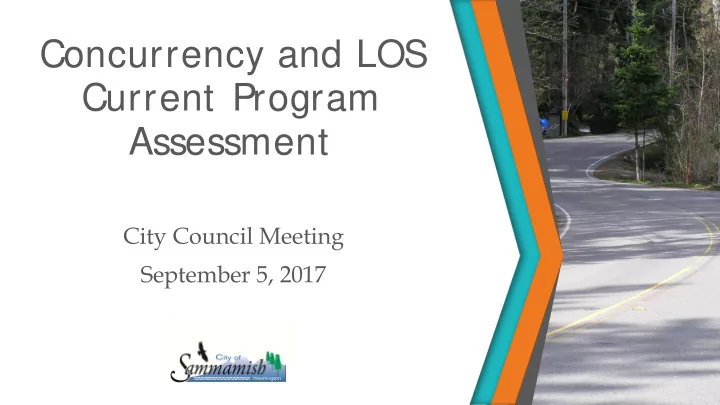

Concurrency and LOS Current Program Assessment City Council Meeting September 5, 2017
Discussion Topics • Project Background & Status • State Guidance for Transportation Planning • City’s LOS Standards • City’s Concurrency Measurement • Advantages & Disadvantages of City’s Program • Next Steps for Concurrency and LOS Reevaluation
Background Goals for the transportation master plan Complete connections Supported by the Fundable & for all modes community implementable In-depth community Safe & efficient Modern concurrency • • • conversation movement for all system that forwards people mobility objectives Creating public buy- • Improves mobility in for new priorities Flexible impact fee • • and approaches and respects program tailored to community character plan Create civic • Reconsider how champions for Fiscally sustainable • • transportation implementation based on prioritized success is defined actions
TMP Public Outreach-To-Date • Pop-up Studios: August 16-19 th • Online presence and priorities mini poll: 360 responses and counting • September 7 th TMP Workshop: 6:30-8:30pm in Council chambers
Mini Poll Preliminary Results: What’s the right balance for Sammamish? Slight preferences towards: • Reducing commute times over improving local street mobility • Connecting the city’s street network over directing traffic towards arterials • Relieving vehicular congestion over providing non-motorized improvements • Supporting more transit options over not doing so
LOS and Concurrency Program GMA Strategies to Balance Growth with Transportation Performance: • Level of Service (LOS) standards are set for transportation facilities • The City’s concurrency program maintains the LOS standards over time • Impact fees paired with concurrency ensure that “growth pays for growth”
Washington State Growth Management Act (GMA) The GMA requires communities to consider the following when updating long-range transportation plans: • Travel forecasts align with land use assumptions • Intergovernmental coordination • Define LOS objectives • Projects align with LOS objectives • Ultimate list of projects is financially realistic
Sammamish’s Intersection LOS Generally accepted measure of driver experience during the peak hour. • LOS D for intersections that include a Principal Arterial , except in cases where LOS D cannot be obtained with three approach lanes per direction. In these cases, LOS E is considered acceptable. • LOS C for intersections that include Minor Arterial or Collector roadways.
Intersection LOS • Delay thresholds for intersections • Uses standard methods with some divergence from 2010 Highway Capacity Manual (HCM) methodology TABLE 1 INTERSECTION LOS CRITERIA (AVERAGE DELAY PER VEHICLE) Signalized Intersections Two-way and all-way Level of Service and Roundabouts Stop-Controlled Intersections < 10 < 10 A > 10 to 20 > 10 to 15 B C > 20 to 35 > 15 to 25 D > 35 to 55 > 25 to 35 E > 55 to 80 > 35 to 50 F > 80 > 50
Segment Evaluation Methodology • Segment and Corridor evaluation are guided by City Policy • Compare average weekday daily traffic (AWDT) volume to an adopted roadway capacity • Segment’s daily volume must be less than the segment’s estimated capacity
Segment Evaluation Segment Capacity is defined by some fairly traditional metrics such as: • Number of lanes • Functional classification • Principal, minor arterial, collector, neighborhood collector • Lane width • 10, 11, or 12 foot lanes • Median or turn lane treatments • Ensures turning vehicles do not impede traffic flow
Segment Evaluation Segment Capacity is also defined by less traditional metrics: • Shoulders and bike lanes • Increase capacity up to 580 daily vehicles for every foot of width up to 8 feet • Non-motorized facilities • Increases person-moving capacity, not car-carrying capacity
Segment Evaluation Background assumptions for the LOS AWDT threshold definitions:
Corridor Evaluation • At the corridor level, concurrency is evaluated by a volume-weighted average of the segments that make up the corridor • The City has 10 designated corridors as concurrency corridors in the 2015 Comprehensive Plan • Corridors can pass concurrency even if one or more of the segments along the corridor fail
Current City Concurrency Measurement • LOS is a baseline for City’s concurrency program. • A development’s trip generation cannot cause an intersection or corridor to fail the City’s standard once projects in six-year TIP are committed. • The LOS capacity calculations in a concurrency test take into account what will be constructed in the next six years.
Current City Concurrency Measurement • Concurrency test uses the City’s traffic demand model to distribute and assign trips and check LOS. • If the concurrency test passes, the development is certified and transportation impact fees are received by the City
Advantages of the City’s Program • Volume-to-capacity at the corridor level includes facilities such as sidewalks, bike lanes and parallel trails -- incentivizes development of “complete streets.” • Current intersection and corridor standards result in a low level of existing deficiencies -- more project costs funded by impact fees . • Program considers peak hour intersection delay, an accepted measure of driver experience .
Disadvantages of the City’s Program • Non-motorized facilities in the capacity calculation do not connect well to the driver’s experience . • Weighted average of segments to determine corridor concurrency provides flexibility but could miss key issues on segments . • The use of daily traffic volumes to calculate segment and corridor performance misses peaking issues that impact commutes . • The methodology is poorly documented . • The program focuses on arterials and results in prioritizing the north-south corridors . 2
Next Steps Task Date Current City LOS and Concurrency Program September 5, 2017 Council Meeting Review Explore alternative LOS and concurrency models - September 19, 2017 Council Meeting best practices review Concurrency hands-on technical meetings (Oct & October & November, with updates at each Nov) w/Council to identify preferred concurrency Council Meeting approach Concurrency and LOS proposals – develop revised Now to mid-2018 with regular updates at program Council Meetings
Thank you Questions?
Extra slides
Current City Concurrency Test Steps
Recommend
More recommend